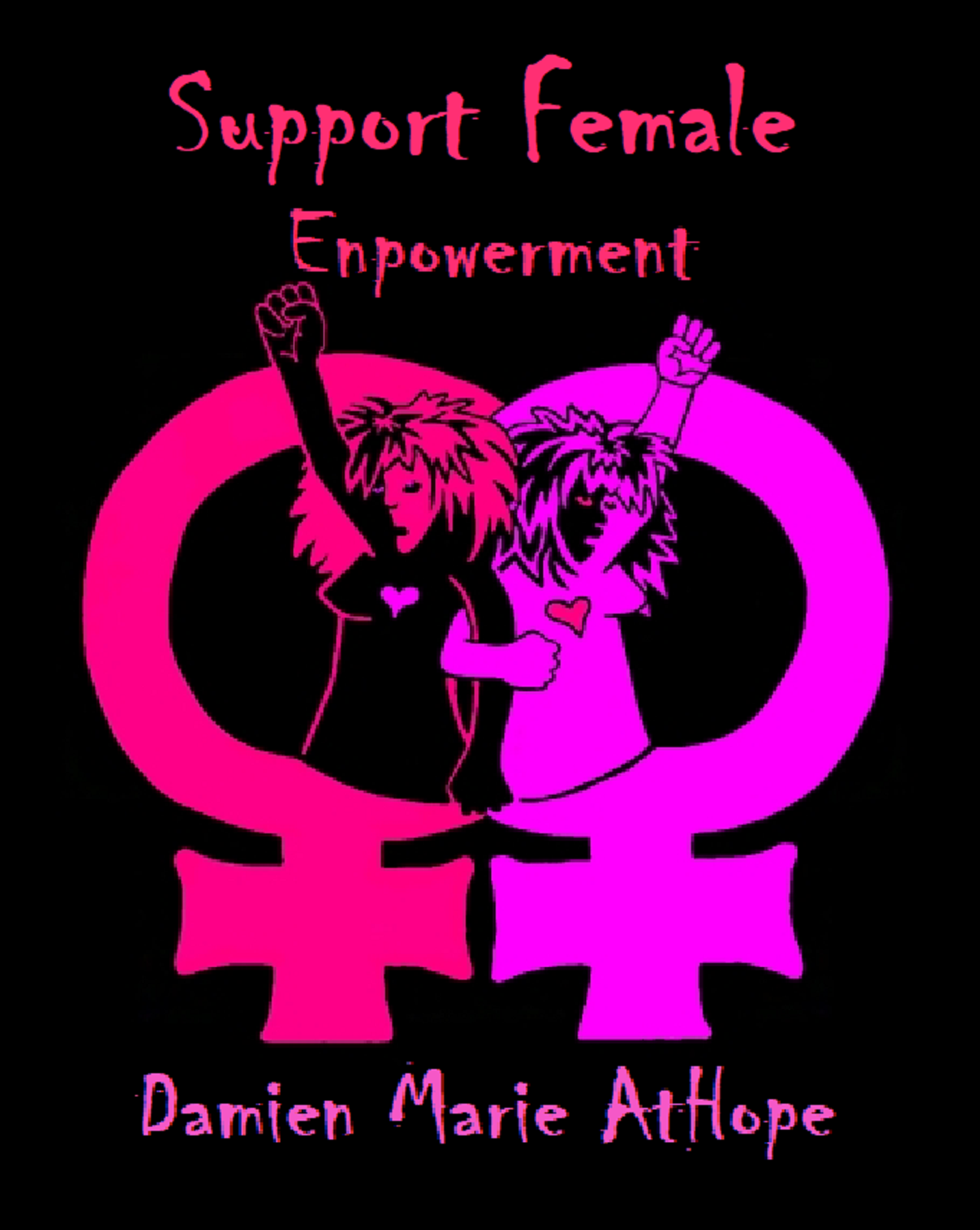
“What a sexist misogynistic post! Women also work and are also at risk to get infected daily, and they bring food and money home. And in the parts of the world where they mostly stay home waiting for a man to bring something, it’s only the fault of the evil patriarchal system.” – Victoria Gubko
“Victoria Gubko That is noT WhaT is Trying To say. He is only saying the middle-class family has a struggling daily routine. They are showing a mother holding da leash for a father, so it’s a Team effort. I understand WhaT you’re saying Tho.” – Commenter
“Victoria Gubko, I agree with your view, however, I read it that because you are perceived as middle class, you can still be in poverty.” – Commenter2
Damien AtHope Atheist-Humanist Philosopher & Pre-Historical Writer/Researcher at damienmarieathope.com
Damien AtHope “Women work, so this is either a limited post only for some or is not accessible for all. Or it is just sexism glorifying itself as the one true hero MAN, manly men to save the day and all non-men live in weakness hoping only for the greatest of all humans the MAN. Well, I see the value of Women and all work is doable by women. We need to start valuing all genders and their important input.”
“Damien AtHope toxic masculinity!” – Victoria Gubko
Damien AtHope “Victoria Gubko Tell it… Toxic masculinity is so common people don’t even see it. So I try to be understanding, but we still have to be hard truth soldiers and tell the truth of both obvious and more hidden sexism, and how vile it is to a flourishing humanity, we all need.”
Gender Inequality in the United States
“Gender inequality in the United States has been diminishing throughout its history and significant advancements towards equality have been made beginning mostly in the early 1900s. However, despite this progress, gender inequality in the United States continues to persist in many forms, including the disparity in women’s political representation and participation, occupational segregation, and the unequal distribution of household labor. The alleviation of gender inequality has been the goal of several major pieces of legislation since 1920 and continues to the present day. As of 2021, the World Economic Forum ranks the United States 30th in terms of gender equality out of 149 countries.” ref
“In addition to the inequality faced by women, inequality, prejudice, and violence against men, transgender men and women, as well as gender nonconforming individuals and non-binary individuals, are also prevalent in the United States. Transgender individuals suffer from prejudices in the workforce and employment, higher levels of domestic violence, higher rates of hate crimes, especially murder, and higher levels of police brutality when compared to the cisgender population.” ref
“In 1920, the Nineteenth Amendment to the United States Constitution, which insured women’s suffrage (although some individual states allowed women the right to vote as early as 1869), was ratified. In addition, the Women’s Bureau of the Department of Labor was created to monitor working conditions for women in the workforce. In 1961, the President’s Commission on the Status of Women was started, initially chaired by Eleanor Roosevelt. This commission found that women were suffering considerable workplace discrimination. In 1963, the Equal Pay Act was passed, which made it illegal for a woman to be paid less than a man working in the same position. The Civil Rights Act of 1964 also made discriminatory hiring on the basis of gender illegal. The affirmative action policy of 1965 was expanded in 1967 to cover women as well as racial minorities.” ref
“In 1973, women’s right to safe and legal abortion was established by the Supreme Court’s ruling in Roe v. Wade. In 1968, sex-segregated job advertisements were declared illegal by the Equal Employment Opportunity Commission, this decision was upheld by the Supreme Court in 1973; this allowed women to apply for higher-paying jobs formally restricted only to male applicants. In 1972, Title IX of the Education Amendments, which reads “No person in the United States shall, on the basis of sex, be excluded from participation in, be denied the benefits of, or be subjected to discrimination under any educational program or activity receiving federal financial assistance,” was passed.” ref
“In June 2022, the Supreme Court overruled Roe in Dobbs v. Jackson on the grounds that the substantive right to abortion was not “deeply rooted in this Nation’s history or tradition”, nor considered a right when the Due Process Clause was ratified in 1868, and was unknown in U.S. law until Roe. This view was disputed by some legal historians and criticized by the dissenting opinion, which argued that many other rights—contraception, interracial marriage, and same-sex marriage—did not exist when the Due Process Clause was ratified in 1868, and thus, by the Dobbs majority’s logic, were not constitutionally protected.” ref
“In 1986, in the decision of Meritor Savings Bank v. Vinson, sexual harassment was established as illegal and discriminatory. The Family Medical Leave Act of 1993 guarantees that new parents can retain their jobs for 12 weeks after the birth of the child; this unpaid leave is the only form of paternal leave protected by law in the United States. In 1994, the Violence Against Women Act provided legal protection, as well as funds and services, for rape victims and victims of domestic violence. United States v. Virginia established in 1996 that gender-based admission practices violated the Fourteenth Amendment, and establishing a separate all-female school would not suffice as an alternative to integrating an all-male school. Most recently, in 2009 the Lilly Ledbetter Fair Pay Act of 2009 provides employees (usually female) who suffer from pay discrimination to file a complaint with the government.” ref
“The Equal Rights Amendment, which reads, “Equality of rights under the law shall not be denied or abridged by the United States or by any State on account of sex”, was first introduced to Congress in 1923 and successfully passed both houses of Congress in 1972. However, it failed to be ratified by an adequate number of states and died in 1982. The United States is one of only a few countries which have not ratified the UN Convention on the Elimination of All Forms of Discrimination against Women (US has only signed the treaty).” ref
“More recent research in 2012 has found that attitudes towards gender and societal roles have changed very little since the mid-1990s, with attitudes hovering at about sixty to seventy percent egalitarian. This study theorized that an “egalitarian but traditional” gender frame emerged in popular culture during this period, which supports each gender assuming their traditional roles without appearing sexist or discriminatory, and is responsible for this backlash.” ref
“Benevolent sexism, sometimes referred to as chivalry, which holds women as something to be protected, also has psychological effects. Women who hold these views are more likely to have less ambitious career goals and men who hold these views tend to have a polarized and stereotyped view of women, made up of both very favorable and very unfavorable traits. In such cases, the stereotyped view of women is “favorable in content and yet prejudicial in [its] consequences,” and attempts to provide justification for discriminatory behaviors presented as helpful or paternal.” ref
“Research conducted at Lycoming College has found the enjoyment of sexist humor to be strongly correlated with sexual aggression towards women among male college students. In addition, studies have shown that exposure to sexist humor, particularly humor related to sexual assault, can increase male aggression and their tendency to discriminate against women. One study also asserted that the attitudes behind such humor creates an environment where such discriminatory and possibly violent behavior is acceptable. Men’s tendency to self-report the likelihood that they would commit sexually violent acts has also been found to increase after exposure to sexist humor, as reported by researchers from the University of Kent.” ref
“The Center for American Women and Politics reports that, as of 2013, 18.3% of congressional seats are held by women and 23% of statewide elective offices are held by women; while the percentage of Congress made up of women has steadily increased, statewide elective positions held by women have decreased from their peak of 27.6% in 2001. Women also make up, as of 2013, 24.2% of state legislators in the United States. Among the one hundred largest cities in the United States, ten had female mayors as of 2013.” ref
“In 1977, political science professor Susan Welch presented three possible explanations for this underrepresentation of women in politics: one, that women are socialized to avoid careers in politics; two, that women’s responsibilities in the home keep them away out of both the work force and the political arena; and three, women are more often than men members of other demographic groups with low political participation rates. In 2001, M. Margaret Conway, political science professor at the University of Florida, also presented three possible explanations for the continuation of this disparity: one, similar to Welch’s first explanation, sociological and societal norm discourages women from running; two, women less frequently acquire the necessary skills to hold a political leadership position from nonpolitical activities; and three, gatekeeping in party politics prevents women from running.” ref
“The United States is falling behind other Western countries in the percentage of women engaged in the workforce. In 2020, the percent of American women working fell to its lowest levels since 1988. Researchers from the Institute for Women’s Policy Research at the University of California Hastings College of Law argue that this growing gap is due to a lack of governmental, business and societal support for working women. They ranked the United States last out of 20 industrialized countries in an index that measured such programs as family leave, alternative work arrangements, part-time employment, and other means to make workplaces more flexible and family-friendly. The United States is also the only industrialized nation that does not have a paid parental leave policy mandated by law, and is one of only four countries worldwide that does not; in addition, fully paid maternity leave is only offered by around 16 percent of employers in the United States.” ref
“Jane Wilke from the University of Connecticut found that men’s support of the idea that men should be the sole source of income in a married couple decreased from 32 to 21 percent from 1972 to 1989; in practice only 15 percent of households were supported by a male spouse’s income alone at the time of the study.” ref
“Women continuously are being mistreated and sexually discriminated against explicitly in the workplace today. This has been an ongoing issue and will most likely continue until something changes in the occupational sphere. According to a study conducted by researchers at California State University, Northridge, when an individual with a PhD applies for a position at a university, that individual is significantly more likely to be offered a higher level of appointment, receive an offer of an academic position leading to tenure, and be offered a full professorship if they are a man when compared to a woman of comparable qualifications. However, these findings have been disputed, with multiple studies finding universities pushed to hire more women, resulting in females being given a 2:1 advantage over males in science, technology engineering and mathematics fields.” ref
“Another study found that women were significantly less likely to receive a job offer or an interview for a high-paying waiter position when compared to equally qualified men; this study also found that such hiring discrimination may be caused in part by customer’s discrimination of preference for male wait staff, but that it could not be concluded, since the male/female gap could be explained by the fact that more female waiters than male, such that the preferred hiring of male waiters could actually help equality. Similarly, research conducted at the University of California, Davis focusing on academic dermatology revealed a significant downward trend in the number of women receiving funding from the National Institutes of Health, which the authors concluded was due to a lack of support for women scientists at their home institutions.” ref
“Research from Lawrence University has found that men were more likely to be hired in traditionally masculine jobs, such as sales management, and women were more likely to be hired in traditionally feminine jobs, such as receptionist or secretary. However, individuals of either gender with masculine personality traits were advantaged when applying for either masculine or feminine jobs, indicating a possibly valuing of stereotypically male traits above stereotypically female traits. Occupational gender segregation takes the form of both horizontal segregation (the unequal gender distribution across occupations) and vertical segregation (the overrepresentation of men in higher positions in both traditionally male and traditionally female fields).” ref
“According to William A. Darity, Jr. and Patrick L. Mason, there is a strong horizontal occupational division in the United States on the basis of gender; in 1990, the index of occupational dissimilarity was 53%, meaning 53% of women or 47% of men would have to move to a different career field in order for all occupations to have equal gender composition. While women have begun to more frequently enter traditionally male-dominated professions, there have been much fewer men entering female-dominated professions; professor of sociology Paula England cites this horizontal segregation of careers as a contributing factor to the gender pay gap.” ref
“US women spend over twice as much time on housework as men, averaging an extra 65 minutes per day (7.6 hours per week) as of 2010. If the women are employed, or highly-paid, they don’t do less housework. In fact, when women work or earn more than their husbands, they do more housework. This has been explained as a way to make their career success less threatening, and reassert traditional sexuality. US women are reluctant to delegate housework to men partly because they believe that it won’t be done properly. Women are, on average, more concerned about undone housework, an attitude gap that has been attributed to socialization and societies that hold women responsible for the state of the home. In households and societies where gender equality is more highly valued, less time overall is spent on housework.” ref
“Stephanie Coontz, a professor of family history at Evergreen State College, noted that one of the factors contributing to the gender inequality in the United States is that most men still expect women and men to assume traditional gender roles in the households and for women to carry out a larger share of the housework. This has been confirmed by a number of other studies; for example Makiko Fuwa from University of California, Irvine noted that while there has been movement towards greater equality, “in 1995 American women still spent nearly twice as much time on housework than men” and there is also a segregation of household tasks. This gendered division of household labor creates what is known as the second shift or double burden, where working women in a heterosexual couple with a working partner spend significantly more time on childcare and household chores.” ref
“Researchers from the University of Maryland have found that while men have steadily begun to perform more household labor since 1965, most of the essential and traditionally feminine tasks are still carried out by women; men generally carry out more nonessential or infrequent tasks, such as taking out the trash or mowing the lawn. While both genders tend to have roughly equal amounts of leisure time, men have more uninterrupted leisure time when compared to women. Researchers from the University of Michigan have found that from 1970 to 1985, the percentage of men and women who supported traditional social roles for wives and believed that maternal employment damages mother-child relationships or children’s development decreased. Working mothers tend to get less sleep when compared to their working husbands. Even in households where both parents are working, women in heterosexual relationships do on average 65% of child care, and are 2.5 times as likely to wake up in the middle of the night to do so.” ref
“With regards to the gender pay gap in the United States, International Labour Organization notes as of 2010 women in the United States earned about 81% of what their male counterparts did. While the gender pay gap has been narrowing since the passage of the Equal Pay Act, the convergence began to slow down in the 1990s. In addition, overall wage inequality has been increasing since the 1980s as middle-wage jobs are decreasing replaced by larger percentages of both high-paying and low-paying jobs, creating a highly polarized environment.” ref
“However numerous studies dispute the claim that discrimination accounts for the majority of the pay gap. When adjusting for industries commonly chosen, choices, hours worked, and benefits received, the pay gap returns to 5%, which has been attributed to less aggressive pay negotiating in women. It has been argued that these choices are the result of gender stereotypes. One study actually found that before 30, females made more than males, and hypothesized that choosing a family over a career resulted in the drop of the female wage advantage during the thirties. According to researchers at the University of California, Berkeley and the University of Illinois at Urbana–Champaign, the primary cause of this gap is discrimination manifested in the tendency of women to be hired more frequently in lower paying occupations, in addition to the fact that male dominated occupations are higher paying than female dominated occupations, and that, even within comparable occupations, women are often paid less than men.” ref
“In medicine, female physicians are compensated less, despite the fact that evidence suggest that the quality of care female physicians provide may be higher than that of male physicians. Gender inequality is still seen in health care, in cases of women seeking emergency room care for serious conditions such as stroke and heart attacks they are 33% more likely to receive a misdiagnosis in comparison to men (Miller). On top of receiving incorrect treatment, when seeking treatment for autoimmune disorders which affect more women than men. It takes an average of seeking care from five different doctors and a span of 4 years to receive a diagnosis (Miller). Women’s health has come a long way and with help from the FDA and NIH making new policies to include more research gender specific for women, the gap is slowly closing.” ref
“Health care providers respond differently to pain for cisgender men and women. Cisgender women aged 55 and older are prescribed pain medication less frequently or with lower dosages than their male counterparts. Women are more often undertreated than men. Cisgender women also receive less preventative care like flu shots and cholesterol screening than cisgender men. Cisgender women have fewer visits to the doctors compared to cisgender men with similar demographic and health backgrounds. Structural racism and gender inequality affect access and awareness to healthcare and fertility care, like contraceptives, family planning resources, and sex education. Black and American Indian/Alaska Native cisgender women have a higher risk of infertility compared to White cisgender women. African American women are more likely to have chronic diseases, such as hypertension.” ref
“According to the Centers for Disease Control and Prevention, about 700 cisgender women in the United States die from pregnancy-related complications annually. Black and American Indian/Alaska Native (AI/AN) cisgender women have higher rates of pregnancy-related deaths, with two to three times greater than the rate for white cisgender women. The gap widens for cisgender women ages 30 and over. The pregnancy related mortality rates are four to five times higher for Black and AI/AN cisgender women ages 30 years and older compared to their white counterparts.” ref
“In addition to the gender pay gap, a “family gap” also exists, wherein women with children receive about 10-15% less pay when compared to women without children. According to Jane Waldfogel, professor of social work and public affairs at Columbia University, this family gap is a contributing factor to the United States’ large gender pay gap. She also noted that men did not seem to be affected by this gap, as married men (who are more likely to have children) generally earned higher than unmarried men.” ref
“The gender pay gap has continued to grow throughout the years due to a plethora of reasons. The gender pay gap refers to the median annual pay of all woman who work full-time and year-round, thus compared to the pay of a similar background of men. There is not one reason behind this gender pay gap, rather the pay gap is a result of many factors that cannot be apparent to the general public. As the gender pay gap is the racial pay gap that exists in our country today, and has been present since women were given the right to work. Not only are women discriminated against for their gender, but also women are discriminated against for their race. The racial pay gap in the workplace is just another aspect of the pay gap issue that our society needs to overcome as soon as possible. Overall, different groups of women experience distinct gaps in pay in the workplace due solely to their race.” ref
Asian
“Generally, among women of all ethnicities and races, the hourly earnings of Asian and white women tend to be higher than African American and Hispanic women A 2016 study by the Pew Research Center reported that Asian women, on average, receive about 18 dollars an hour, while white women earn 17 dollars, African American women get 13 dollars, and Hispanic women receive 12 dollars. The study also found that in 2015 Asian women earned about 87 cents per dollar earned by white men in median hourly earnings. About 45 percent of Asian American mothers provide nearly 40 percent of their families’ income, making these households reliant on this income.” ref
Hispanic
“Female Hispanic women earn wages far less than their women and male counterparts. According to the Institute for Women’s Policy Research, in 2017, the median salary for a white male was $60,388, $46,513 for white women, and $32,002 for Latina women. They earn the lowest among all ethnicities including Asian and Black women workers. In 2017, for every 1 dollar a white male worker earns, a Hispanic woman earns 53 cents, whereas a white female employee makes 80.5 cents for each dollar a man makes. In other words, Hispanic women earn 47 percent less money than white males and 31 percent less money than white females. The Institute for Women’s Policy Research stated that in 2016, 31.2 percent of Latina women were unmarried and the primary provider for their family and 21.3 percent were married and still the families’ primary source of income. This disparity of income interferes with Hispanic women’s ability to afford childcare services and to take time off from work.” ref
Native American
“Native American women earn significantly less than other women and men in the country. On average, it would take a Native American woman an additional 9 months to receive the same annual salary as a white man. In addition, the average Native American woman earns approximately $0.58 per every individual dollar a white man earns. In comparison, a white woman earns $0.77 per each dollar earned by a white man. The annual wage gap between a Native American woman and a white woman is approximately $24,443. Because 67% of Native American mothers are the primary breadwinners of their family, this wage gap can cause higher poverty rates for Native American women.” ref
Caucasian
“The pay gap between Caucasian women and Caucasian men is substantial. In 2018, the median weekly pay for all Caucasian women with full-time job was $789 while the median weekly pay for men was $973. These numbers depict that on average, white women make around 81% of what white men do. While these numbers clearly describe the inequality between white men and white women, there are far greater differences in wages for women who are not white.” ref
“Increased awareness of gender inequality in the workplace has increased women’s salaries by 1.6% between 2016 and 2017. Women’s annual salaries have continued to slightly increase in the years following this change. One of the biggest factors that creates this economic inequality is parenting. While many white women are staying home to take care of their family, men are continuing to work and earn money. When white women eventually go back to work, they make about 39% less than their peers who are not mothers. In general, these differences in salary can be attributed to the scarcity of free childcare services in America.” ref
African American
“As of 2017, African American women make 61 cents to the white man’s dollar. This is much lower than the earnings ratio for all women in this country, which is 80 cents to the white man’s dollar. According to data from the Economic Policy Institute, the median earnings of full-time, full- year workers for black men is about $5,000 higher than the earnings of Black women. In the top 25 states with the largest numbers of Black women working full-time, year-round, the pay compared to white men ranges from about 48 to 68 cents for every white man’s dollar. For example, in places like Washington, D.C. and Mississippi, Black women still only make 55 cents to the white man’s dollar even though they have the highest amount of full-time working black women. Furthermore, 80% of Black women are the sole source of income in their household and 4 million Black women are reported to be the heads of their households. Even still, 1.2 million of those 4 million women are living below the poverty line.” ref
“There are many reasons why these disparities exist. Black women are more likely to be found occupying lower paying service jobs than any other demographic. Only 2.2% of all board seats in Fortune 500 companies are held by Black women. Very few black women advance to executive leadership positions due to lack of mentors and peers who are also black women. White women, in contrast, are typically able to find these connections with relative ease. Black women also report dealing with microaggressions and workplace harassment at high rates by their colleagues in the workplace. They feel constant pressure to perform better than their peers so that they can receive the same treatment and opportunities. These barriers prevent African American women from occupying the working positions that they need to get to higher, better paying positions in this country.” ref
Education
“Literacy and enrollment in primary and secondary education are at parity in the United States, and women are overrepresented in tertiary education. There is, however, a notably gender segregation in degree choice, correlated with lower incomes for graduates with “feminine” degrees, such as education or nursing, and higher incomes for those with “masculine” degrees, such as engineering. Females started outnumbering males in higher education in 1992.” ref
Gender inequality in elementary and middle schools
“To study gender inequality in elementary and middle schools, researchers from NYU and Indiana University used data from the nationally representative Early Childhood Longitudinal Study, specifically the 1998 to 1999 and 2010 to 2011 cohorts. When comparing average math test scores of boys and girls in kindergarten, they did not discover an average gender gap. However, when looking at data from students in second or third grade, the researchers discovered that boys perform better on the math tests (by a standard deviation of 0.25 average gender gap).” ref
“The researchers also found that when teachers were asked to compare a boy and a girl of the same socio-economic status and race who received the same scores on math tests and had similar behavioral records in school, teachers overwhelmingly stated that the boy had superior mathematical abilities, a finding replicated in a study over a decade later. It is therefore possible that the gender gap in mathematical abilities among kindergarteners could be much less apparent in the United States today if teachers exhibited less gender bias in evaluating students’ abilities, as evidenced by these replicated studies that demonstrate a systematic undervaluing of girls’ mathematical abilities by teachers, which has likely contributed to a false perception of girls’ abilities as being lower than test scores would indicate.” ref
“So often in our society, girls receive signals from an early age that they are not good at math, or that boys are simply better. This can occur at home, when wives ask their husbands for help when it comes to math. In 2013, women received 57% of all bachelor’s degrees, however, they only received 43% of math degrees, 19% of engineering degrees, and 18% of computer science degrees. At school and at home, many young girls receive the message that they either “have the math gene or they do not.” When a mother tells her daughter that she wasn’t good at math in school, oftentimes, the daughter’s mathematical achievement will decrease. Oftentimes, women do not realize they are sending these messages to their daughters.” ref

I strive to be a good human ethical in both my thinking and behaviors thus I strive to be:
Anti-racist, Anti-sexist, Anti-homophobic, Anti-biphobic. Anti-transphobic, Anti-classist, Anti-ablest, Anti-ageist, and as Always Antifascist.
In fact, I want to strive to avoid as much as I can bigoted thinking towards others based on their perceived membership or classification based on that person’s perceived political affiliation (Well: within reason, justice, and ethics), sex/gender, beliefs (Well: within reason, justice, and ethics), social class (Well: within reason, justice, and ethics), age, disability, religion (Well: within reason, justice, and ethics), sexuality (Well: within reason, justice, and ethics), race, ethnicity, language (Well: within reason, justice, and ethics), nationality, beauty, height, occupation (Well: within reason, justice, and ethics), wealth (Well: within reason, justice, and ethics), education, sport-team affiliation, music tastes or other personal characteristics (Well: within reason, justice, and ethics).
Although, I am a “very”, yes, VERY strong atheist, antitheist as well as
antireligionist, My humanity is just as strong and I value it above my
disbeliefs. My kind of people are those who champion humanity, the one’s
who value kindness, love justice, and support universal empowerment for
all humans, we are all equal in dignity, and all deserve human rights, due
self-sovereignty.




While hallucinogens are associated with shamanism, it is alcohol that is associated with paganism.
The Atheist-Humanist-Leftist Revolutionaries Shows in the prehistory series:
Show two: Pre-animism 300,000 years old and animism 100,000 years old: related to “Anarchism and Socialism”
Show tree: Totemism 50,000 years old: related to “Anarchism and Socialism”
Show four: Shamanism 30,000 years old: related to “Anarchism and Socialism”
Show five: Paganism 12,000 years old: related to “Anarchism and Socialism”
Show six: Emergence of hierarchy, sexism, slavery, and the new male god dominance: Paganism 7,000-5,000 years old: related to “Anarchism and Socialism” (Capitalism) (World War 0) Elite and their slaves!
Prehistory: related to “Anarchism and Socialism” the division of labor, power, rights, and recourses: VIDEO
Pre-animism 300,000 years old and animism 100,000 years old: related to “Anarchism and Socialism”: VIDEO
Totemism 50,000 years old: related to “Anarchism and Socialism”: VIDEO
Shamanism 30,000 years old: related to “Anarchism and Socialism”: VIDEO
Paganism 12,000 years old: related to “Anarchism and Socialism” (Pre-Capitalism): VIDEO
Paganism 7,000-5,000 years old: related to “Anarchism and Socialism” (Capitalism) (World War 0) Elite and their slaves: VIEDO
Paganism 5,000 years old: progressed organized religion and the state: related to “Anarchism and Socialism” (Kings and the Rise of the State): VIEDO
Paganism 4,000 years old: related to “Anarchism and Socialism” (First Moralistic gods, then the Origin time of Monotheism): VIEDO
I do not hate simply because I challenge and expose myths or lies any more than others being thought of as loving simply because of the protection and hiding from challenge their favored myths or lies.
The truth is best championed in the sunlight of challenge.
An archaeologist once said to me “Damien religion and culture are very different”
My response, So are you saying that was always that way, such as would you say Native Americans’ cultures are separate from their religions? And do you think it always was the way you believe?
I had said that religion was a cultural product. That is still how I see it and there are other archaeologists that think close to me as well. Gods too are the myths of cultures that did not understand science or the world around them, seeing magic/supernatural everywhere.
I personally think there is a goddess and not enough evidence to support a male god at Çatalhöyük but if there was both a male and female god and goddess then I know the kind of gods they were like Proto-Indo-European mythology.
This series idea was addressed in, Anarchist Teaching as Free Public Education or Free Education in the Public: VIDEO
Our 12 video series: Organized Oppression: Mesopotamian State Force and the Politics of power (9,000-4,000 years ago), is adapted from: The Complete and Concise History of the Sumerians and Early Bronze Age Mesopotamia (7000-2000 BC): https://www.youtube.com/watch?v=szFjxmY7jQA by “History with Cy“
Show #1: Mesopotamian State Force and the Politics of Power (Samarra, Halaf, Ubaid)
Show #2: Mesopotamian State Force and the Politics of Power
Show #3: Mesopotamian State Force and the Politics of Power (Uruk and the First Cities)
Show #4: Mesopotamian State Force and the Politics of Power (First Kings)
Show #5: Mesopotamian State Force and the Politics of Power (Early Dynastic Period)
Show #6: Mesopotamian State Force and the Politics of Power
Show #7: Mesopotamian State Force and the Politics of Power (Sargon and Akkadian Rule)
Show #9: Mesopotamian State Force and the Politics of Power (Gudea of Lagash and Utu-hegal)
Show #12: Mesopotamian State Force and the Politics of Power (Aftermath and Legacy of Sumer)

The “Atheist-Humanist-Leftist Revolutionaries”
Cory Johnston ☭ Ⓐ Atheist Leftist @Skepticallefty & I (Damien Marie AtHope) @AthopeMarie (my YouTube & related blog) are working jointly in atheist, antitheist, antireligionist, antifascist, anarchist, socialist, and humanist endeavors in our videos together, generally, every other Saturday.
Why Does Power Bring Responsibility?
Think, how often is it the powerless that start wars, oppress others, or commit genocide? So, I guess the question is to us all, to ask, how can power not carry responsibility in a humanity concept? I know I see the deep ethical responsibility that if there is power their must be a humanistic responsibility of ethical and empathic stewardship of that power. Will I be brave enough to be kind? Will I possess enough courage to be compassionate? Will my valor reach its height of empathy? I as everyone, earns our justified respect by our actions, that are good, ethical, just, protecting, and kind. Do I have enough self-respect to put my love for humanity’s flushing, over being brought down by some of its bad actors? May we all be the ones doing good actions in the world, to help human flourishing.
I create the world I want to live in, striving for flourishing. Which is not a place but a positive potential involvement and promotion; a life of humanist goal precision. To master oneself, also means mastering positive prosocial behaviors needed for human flourishing. I may have lost a god myth as an atheist, but I am happy to tell you, my friend, it is exactly because of that, leaving the mental terrorizer, god belief, that I truly regained my connected ethical as well as kind humanity.
Cory and I will talk about prehistory and theism, addressing the relevance to atheism, anarchism, and socialism.
At the same time as the rise of the male god, 7,000 years ago, there was also the very time there was the rise of violence, war, and clans to kingdoms, then empires, then states. It is all connected back to 7,000 years ago, and it moved across the world.
Cory Johnston: https://damienmarieathope.com/2021/04/cory-johnston-mind-of-a-skeptical-leftist/?v=32aec8db952d
The Mind of a Skeptical Leftist (YouTube)
Cory Johnston: Mind of a Skeptical Leftist @Skepticallefty
The Mind of a Skeptical Leftist By Cory Johnston: “Promoting critical thinking, social justice, and left-wing politics by covering current events and talking to a variety of people. Cory Johnston has been thoughtfully talking to people and attempting to promote critical thinking, social justice, and left-wing politics.” http://anchor.fm/skepticalleft
Cory needs our support. We rise by helping each other.
Cory Johnston ☭ Ⓐ @Skepticallefty Evidence-based atheist leftist (he/him) Producer, host, and co-host of 4 podcasts @skeptarchy @skpoliticspod and @AthopeMarie
Damien Marie AtHope (“At Hope”) Axiological Atheist, Anti-theist, Anti-religionist, Secular Humanist. Rationalist, Writer, Artist, Poet, Philosopher, Advocate, Activist, Psychology, and Armchair Archaeology/Anthropology/Historian.
Damien is interested in: Freedom, Liberty, Justice, Equality, Ethics, Humanism, Science, Atheism, Antiteism, Antireligionism, Ignosticism, Left-Libertarianism, Anarchism, Socialism, Mutualism, Axiology, Metaphysics, LGBTQI, Philosophy, Advocacy, Activism, Mental Health, Psychology, Archaeology, Social Work, Sexual Rights, Marriage Rights, Woman’s Rights, Gender Rights, Child Rights, Secular Rights, Race Equality, Ageism/Disability Equality, Etc. And a far-leftist, “Anarcho-Humanist.”
I am not a good fit in the atheist movement that is mostly pro-capitalist, I am anti-capitalist. Mostly pro-skeptic, I am a rationalist not valuing skepticism. Mostly pro-agnostic, I am anti-agnostic. Mostly limited to anti-Abrahamic religions, I am an anti-religionist.
To me, the “male god” seems to have either emerged or become prominent around 7,000 years ago, whereas the now favored monotheism “male god” is more like 4,000 years ago or so. To me, the “female goddess” seems to have either emerged or become prominent around 11,000-10,000 years ago or so, losing the majority of its once prominence around 2,000 years ago due largely to the now favored monotheism “male god” that grow in prominence after 4,000 years ago or so.
My Thought on the Evolution of Gods?
Animal protector deities from old totems/spirit animal beliefs come first to me, 13,000/12,000 years ago, then women as deities 11,000/10,000 years ago, then male gods around 7,000/8,000 years ago. Moralistic gods around 5,000/4,000 years ago, and monotheistic gods around 4,000/3,000 years ago.


Damien Marie AtHope (Said as “At” “Hope”)/(Autodidact Polymath but not good at math):
Axiological Atheist, Anti-theist, Anti-religionist, Secular Humanist, Rationalist, Writer, Artist, Jeweler, Poet, “autodidact” Philosopher, schooled in Psychology, and “autodidact” Armchair Archaeology/Anthropology/Pre-Historian (Knowledgeable in the range of: 1 million to 5,000/4,000 years ago). I am an anarchist socialist politically. Reasons for or Types of Atheism
My Website, My Blog, & Short-writing or Quotes, My YouTube, Twitter: @AthopeMarie, and My Email: damien.marie.athope@gmail.com












